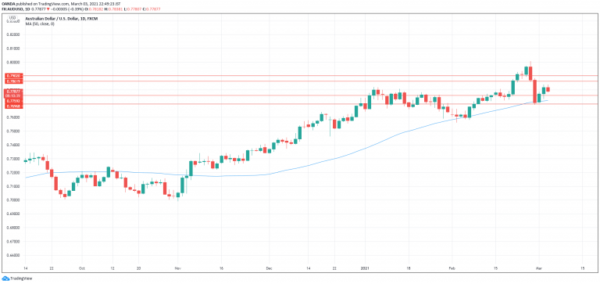The Australian dollar is in negative territory on Wednesday. Currently, the pair is trading at 0.7793, down 0.33% on the day.
Australia GDP rises 3.1%
Australia’s economy grew by 3.1% in the fourth quarter of 2020. This figure was slightly down from the 3.3% gain in Q2, but easily beat the forecast of 2.5%. Much of the gain is attributable to an increase in the price of exports, notably iron ore. An improving global economy has led to stronger demand for Australian exports, which bodes well for the country’s economic growth in 2021.
Despite this solid reading, the Australian dollar has lost ground on Wednesday. Investors appear to have focused on the Q4 year-on-year release, which showed a 1.1% decline compared to Q4 in 2019. Still, this was better than the street consensus of a 1.8% decline.
Despite the Australian dollar’s lacklustre response, the GDP release is significant. The economy continues to lift out of recession and show sustained growth, and Australia is in the enviable position of closing in on pre-Covid economic growth. Finance Minister Josh Frydenberg commented that the economy was recovering more quickly than the government had anticipated, noting that the first time in recorded history that Australia has seen two consecutive quarters of economic growth of more than 3%”.
Over in the US, the ADP Employment report disappointed, with a weak gain of 117 thousand. This was down from the previous release of 174 thousand and nowhere near the forecast of 203 thousand. The big question for investors is whether the weak ADP reading will be followed on Friday, when the official nonfarm payrolls report is released. The forecast stands at 185 thousand, and a significantly lower release could weigh on the US dollar.
AUD/USD Technical
- AUD/USD faces resistance at 0.7861, followed by resistance at 0.7901
- There is weak support at 0.7861. Below, we have support at 0.7759
- The 50-day moving average (MA) remains relevant. It is situated at 0.7721















